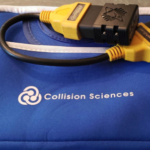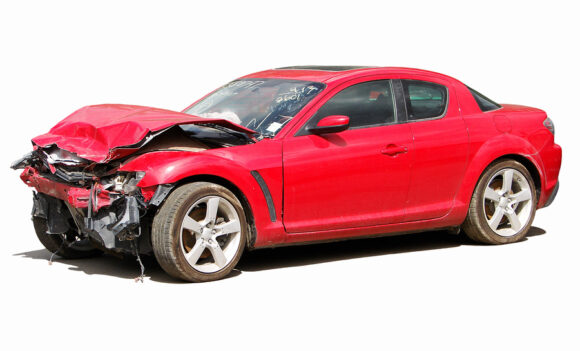Claims professionals have few options if they want access the information stored in event data recorders after a vehicle crash. For most models they use Bosch’s Crash Data Retrieval tool. For Kia and Hyundai, they must use Global Information Technology’s EDR Tool.
But a Canadian technology company says it offers an alternative way of accessing EDR data that doesn’t require the purchase of thousands of dollars in equipment. Collision Sciences Inc., based in Mississauga, Ontario, sells a device that can download data on a smart phone for only $150.
The CrashScan app makes an initial scan that indicates whether any crash data was recorded. For an extra charge — generally $300 — the user can request from Collision Sciences a narrative report that translates the digital codes stored in the EDR into plain language. The report will include information such as whether the airbag was deployed, the force and direction of impact and even the likelihood of injury.

Chief Executive Officer Jason Bayley says his device eliminates the need to invest in the Bosch and GIT tools, which together can cost claims shops $50,000. He said his patented plain-language reporting system also eliminates the need for claims investigators to enroll in a week-long training program to understand the digital codes that the Bosch and GIT tools produce.
The National Highway Traffic Safety Administration has required all vehicles to be equipped with EDRs since 2012. In 2015, Congress passed a law establishing that the data on the recorders belongs to the owner of the vehicle.
Bayley said the data is unnecessarily difficult to access, which is why manufacturers are able to charge consumers for the information stored in devices that they own.
General Motors, for example, charges $10 per month to subscribers who sign up for OnStar, a system that uses EDR data to send alerts directly to emergency dispatchers. Toyota in August announced a partnership with CCC Intelligent Solutions to create the Collision Assistance service, which documents accident data and guides vehicle owners through the claims process.
“People should have the right to this data,” Bayley said. “It should be accessible.”
GM pioneered the development of event data records in the 1990s. The devices record various data points, such as engine speed, steering input and whether brakes were applied, in a continuous loop that stops five seconds after a collision is detected. EDRs are usually installed as part of the vehicle’s airbag control module. They can be accessed though an on-board diagnostics port.
Bayley said his company’s CrashScan app uses that port to read the data on vehicle EDRs, just as the Bosch and GIT tools do. He said the patent he obtained for his product protects the technology that converts the digital codes on EDRs into plain language.
Bayley, an engineer, said he saw the need for the technology while he was working as a forensics investigator. He said the cost of acquiring the two EDR readers on the market and accompanying software can be a barrier to entry for claims professionals who want to investigate auto accidents.
While $300 per report may sound expensive, Bayley said there’s a way to bring down that cost. “For insurers, we have developed enterprise subscription models and we will plan to grow our company and improve our products as the industry affords us the opportunity,”he said.
Word has started getting around among claims adjusters. Insurance defense attorney Brian Mizzell discussed the Collision Sciences tool during the Connected Claims conference in Southern California in August. Mizzell said the technology provides an inexpensive option for downloading EDR data, but he said he isn’t certain that courts will accept the data as evidence if a dispute goes to trial.
Bayley said he sees no reason why courts would not accept his reports, since they are based on the same data accessed by the Bosch and GIT tools.
Forensics engineer Alan Cantor, founder and chairman of the board for ARCCA in Philadelphia, said he is familiar with the Collision Science tool and has concerns about it. He said the tool “overreaches,” which is a typical problem with technologies that attempt to predict outcomes.
CrashScan’s reports include conclusions about whether a crash was likely to cause injury. Cantor said only an expert can draw such conclusions after examining all of the evidence.
“Their interpretation of the data goes beyond what I consider to be scientifically valid,” Cantor said. “There is no algorithm to determine if there is an injury or not an injury.”
For example, a rollover accident that crushes the roof of a car can cause serious injury but the EDR report would not detect that because a rollover does not produce enough acceleration. Similarly, he said a seat collapse can also injure a passenger, but no acceleration would be detected to trigger a report of likely injury.
In response, Bayley pointed to a study by Virginia Tech-Wake Forest University, published in 2015, that demonstrated event data recorder measurements can be used to predict occupant injury after vehicle crashes.
“Our report offers similar injury risk data, from the same government databases, which track and merge injury and EDR data,” he said.
Bayley said Collision Science’s tool does not attempt to predict injuries from rollover crashes, although its reports do report risk information for specific and more common front, rear and side impacts.
He said Cantor has not been a customer, so would have limited knowledge about Collision Science’s technology.
“Our product and service is fairly disruptive, and thus I anticipate it will be polarizing, particularly for expert engineers, who also enjoy somewhat of a monopoly on access and reporting on EDR data, which costs insurers thousands per vehicle, typically,” he said.
Was this article valuable?
Here are more articles you may enjoy.


 Cyber Breach Affected 750,000 Canadian Investors, Regulator Says
Cyber Breach Affected 750,000 Canadian Investors, Regulator Says  Musk’s xAI Faces California AG Probe Over Grok Sexual Images
Musk’s xAI Faces California AG Probe Over Grok Sexual Images  What The Return of California’s ‘Death Discount’ Means for Litigation
What The Return of California’s ‘Death Discount’ Means for Litigation  The Return Period for An LA Wildfire-Scale Event May Be Shorter Than You Think
The Return Period for An LA Wildfire-Scale Event May Be Shorter Than You Think 